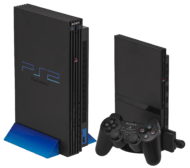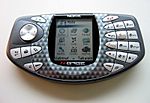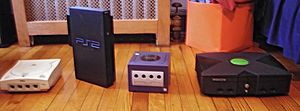History of video game consoles (sixth generation) facts for kids
The sixth generation of video game consoles was a super exciting time for gaming! It started on November 27, 1998, when the Dreamcast was first released in Japan. This era is sometimes called the "128-bit generation" because of how powerful these consoles were.
This generation brought us some truly famous game systems. The main ones were the Dreamcast, PlayStation 2, Nintendo GameCube, and Microsoft Xbox. These consoles offered amazing graphics and new ways to play.
The Dreamcast stopped being made in 2001, but its games were still sold until 2007. The GameCube was discontinued in 2007. The Xbox stopped selling games in 2008 and was fully discontinued in 2009. The PlayStation 2 was the last to go, stopping production in 2013. This officially ended the sixth generation of consoles.
Contents
Awesome Game Systems
Let's take a closer look at the main consoles from this generation. Each one brought something special to the world of gaming!
Comparing the Consoles
Here's a quick comparison of the main consoles from the sixth generation.
| Name | Dreamcast | PlayStation 2 | GameCube | Xbox |
|---|---|---|---|---|
| Logo | ||||
| Made by | Sega | Sony Computer Entertainment | Nintendo | Microsoft |
| Images |  |
 |
 |
 |
| A Dreamcast console, controller, and VMU. | Left: An original PlayStation 2. Right: A slim PlayStation 2. | An indigo GameCube and controller. | An Xbox console and "Type-S" controller. | |
| Launch Price | US$199.99 | US$299.99 | US$199.99 | US$299.99 |
| Best-Selling Game | Sonic Adventure (2.5 million copies) | Grand Theft Auto: San Andreas (19 million copies) | Super Smash Bros. Melee (7.09 million copies) | Halo 2 (8 million copies) |
| Release Date | JP November 27, 1998 NA September 9, 1999 EU October 14, 1999 |
JP September 14, 2001 NA November 18, 2001 EU May 3, 2002 |
NA November 15, 2001 JP February 22, 2002 EU March 14, 2002 |
|
| Discontinued | March 30, 2003 | JP October 28, 2007 EU May 17, 2008 NA June 15, 2009 |
JP June 4, 2006 EU March 11, 2007 NA March 2, 2009 |
|
| Cool Accessories |
|
|
|
|
| Game Discs | CD, 1.2 GB GD-ROM | DVD, CD | GameCube game disc | DVD, CD |
| Online Gaming | Sega Net (2000–2002), Dreamarena (2000-2003) | Online service (2002–present) | Online service (2003-2009) | Xbox Live (2002–now) |
| Can Play Older Games? | No | Yes, PlayStation games | Yes, Game Boy, Game Boy Color, Game Boy Advance games (with Game Boy Player) | No |
Worldwide Sales
Here's how many units each console sold around the world:
| Console | Units Sold |
|---|---|
| PlayStation 2 | 153.6 million |
| Xbox | 24 million |
| GameCube | 21.74 million |
| Dreamcast | 10.6 million |
Handheld Game Consoles
The sixth generation wasn't just about home consoles! There were also some cool handheld devices that let you play games on the go.
| Name | Game Boy Advance / Advance SP / Micro | N-Gage / QD |
|---|---|---|
| Logos | ||
| Made by | Nintendo | Nokia |
| Images |    |
  |
| Left to right: Game Boy Advance, Game Boy Advance SP, Game Boy Micro | Left to right: N-Gage, N-Gage QD | |
| Release Dates | Game Boy Advance:
Game Boy Advance SP:
Game Boy Micro:
|
N-Gage: October 7, 2003 N-Gage QD: May 26, 2004 |
| Discontinued | Game Boy Advance: 2007-2008 | N-Gage: 2006 |
| Launch Prices | GBA: US$99.99
GBA SP: US$99.99 GB Micro: US$99.99 |
N-Gage: US$299.99
N-Gage QD: US$179.99 |
| Game Media | Game Boy Advance cartridge | MultiMediaCard (MMC) |
| Best-Selling Game | Pokémon Ruby and Sapphire (13 million combined) | ? |
| Battery Life | GBA: 15 hours GBA SP: 10-18 hours GB Micro: 5-8 hours |
N-Gage: 2 hours N-Gage QD: 4 hours |
| Units Sold | Worldwide: 81.51 million | Worldwide: 3 million |
Other Handhelds
There were a few other handhelds during this time, though they weren't as widely known:
- Tapwave Zodiac (2003)
- Neo Geo Pocket Color (1999)
-
SwanCrystal (1999)
Handheld Sales
Here's a look at how many of these handhelds were sold:
| Console | Units Sold |
|---|---|
| Game Boy Advance (includes GBA SP and Game Boy Micro) |
81.51 million |
| N-Gage | 3 million |
| Tapwave Zodiac | less than 200,000 units |
| GP32 | 30,000 |
Popular Games
The sixth generation brought us many classic and popular games that are still loved today! Here are some of them:
- Final Fantasy X
- Grand Theft Auto III, Grand Theft Auto: Vice City, and Grand Theft Auto: San Andreas
- Halo: Combat Evolved
- Halo 2
- Kingdom Hearts
- Metal Gear Solid 2: Sons of Liberty and Metal Gear Solid 3: Snake Eater
- Metroid Prime
- Resident Evil 4
- Shenmue
- SoulCalibur
Images for kids
-
The PlayStation 2 was the best-selling system of the sixth generation, selling over 150 million systems, also making it the best-selling console of all time.
-
The Game Boy Advance was the best-selling handheld system.
-
SwanCrystal (2002)
See also
 In Spanish: Videoconsolas de sexta generación para niños
In Spanish: Videoconsolas de sexta generación para niños












